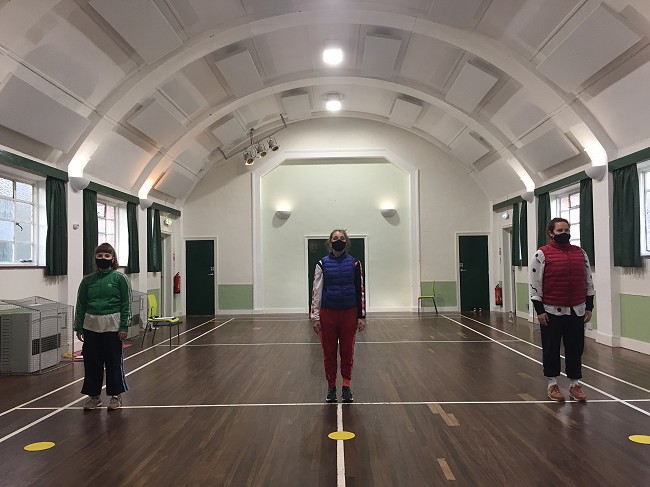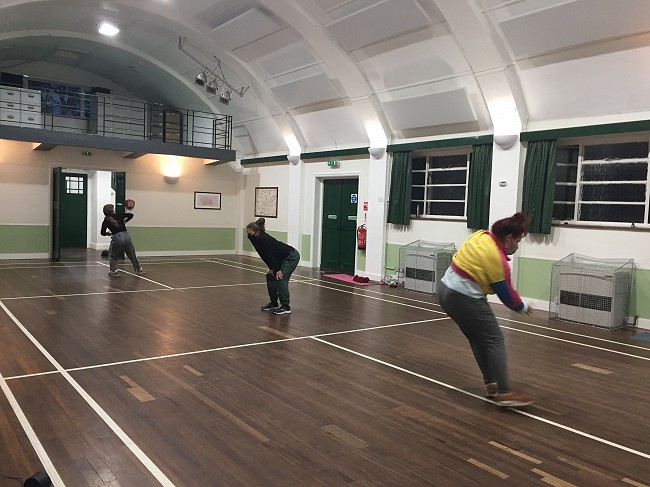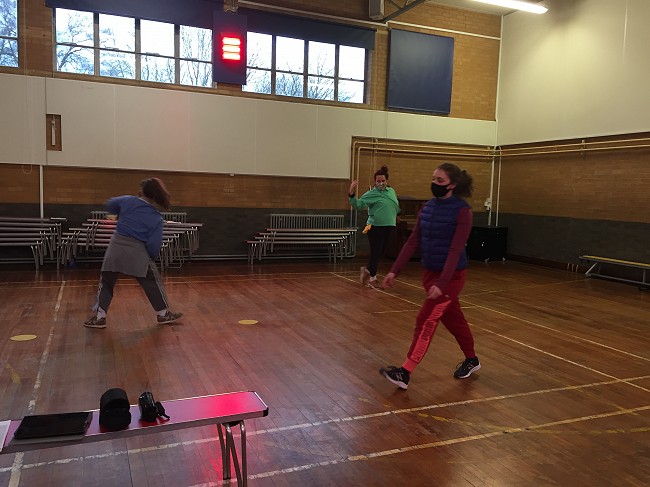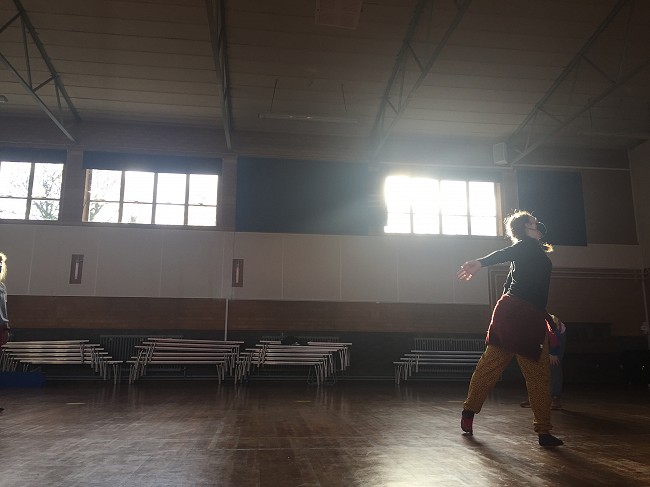
Having had to postpone all of the activity due to happen as part of our Imagination Museum: Mayflower 400 project from March to October 2020, we were due to start a period of development rehearsal for the rescheduled project in January 2021.
We wanted to build on the limited discussions about adaptation that we had been able to have over Zoom as a company during 2020 – rechoreographing sections of the work to make them socially distanced, changing the ending of the piece and preparing to film 3 extracts from the piece in order to create ‘inspiration films’ for our work with schools and families over the coming 6 months. The rehearsal time was much needed and had been pushed back already many times over.
Towards the latter end of 2020, from September onwards, we had been back in rehearsal, in-person, on a few occasions already for other projects. This meant that I, and the dancers (Sarah Blanc, Megan Griffiths, Lucy Starkey, Alice Shepperson), felt like we understood how to make these rehearsals safe. Before the full reality of the new variant of coronavirus and the more rapidly increasing number of COVID-19 cases became apparent, it had seemed totally possible to imagine rehearsing in January.
However, when that reality did begin to dawn on us, and the 4th January announcement of further lockdown measures happened, we entered (what felt to me like) a week of rapid and sometimes fraught discussion and decision-making about what we should do next. I say ‘fraught’ mainly because everything happening at that time made it difficult to know what to do first (in spite of the fact that we had done some contingency planning to prepare for this).
In the end we did decide to go ahead (the Performing Arts-specific guidance on the government website here states clearly that professional rehearsal and performance for recording purposes can continue at this time). It hasn’t felt appropriate to share daily photos and posts about our rehearsals on social media as I would usually do without the opportunity to provide more information about the process we went through to get there. However, I did want to share something about this experience in retrospect, particularly a few of the key things we learnt about making the situation safe and the work that went into the process logistically and emotionally. I’ll try to focus on new learning and personal experiences rather than covering everything, as I know that all of you involved in similar activities to us will already be well-versed in the details of a COVID-specific risk assessment, particularly in terms of cleaning procedures!
(Also just to note that this was just what we did, in line with government guidance and consulting with other companies and our team, I’m not at all suggesting this is the only way to go about things.)

Planning/research
Firstly, and too complex (and dull!) a process to go into in detail here, we went through a lengthy process of trying to determine whether it was really essential that we got back into the studio. It’s at the top of our risk assessment that we will only go back into in-person activity where it can’t be avoided. We asked questions such as:
- Were there other ways we could undertake the rehearsal?
- Was the timing crucial? Were the people involved available at other times? What was the knock-on effect on the rest of the project if we postponed?
- Did all the people involved absolutely need to be there?
This process happened alongside daily checking of government guidance as it was gradually updated and regular checking in with the dancers about how they felt about working together at this time, and ways that we could try to make them feel as safe as possible. That was very much at the forefront of my mind throughout.
Having determined that yes, this rehearsal really did have to happen now, here are some of the things we learnt/found helpful:
Rehearsal space
- I didn’t look for this specifically when I was identifying rehearsal space (as we were limited in terms of what we could afford and what was available in the area where rehearsal needed to happen) but good internet access was really helpful from day 1. Unfortunately one of the dancers in our core cast, Megan, had to self-isolate because her partner had been in contact with a positive COVID case and was awaiting his own test result. In the end, Meg had to join us remotely for the entire rehearsal time (more on that later). Even where live link-up didn’t work, internet access meant we were able to record and send short videos of work-in-progress via WhatsApp, and Meg did the same from home, which meant we could keep moving forward, and felt just that little bit more connected with each other even though it of course wasn’t the same as being in the room together. I’d recommend having a back-up plan in place for how this could work; we had to figure it out as we were going along.

- We were the only ones using our rehearsal spaces during our time together, which gave us a little more peace of mind. Ideally we would only have used one rehearsal space, but had to use two (for reasons that aren’t interesting to go in to here!), but this did mean that on the days that we weren’t in each space, professional cleaning could take place (happening on top of our own cleaning).
- I would recommend having some back-up rehearsal spaces in mind – one of our rehearsal venues pulled out 1 week before we got started, not because of any issues with legality of what we were doing or concerns about how we would be managing rehearsals, but because of other reasons to do with changing management of that venue. Fortunately, I did have two other spaces I was then able to go to and as they already had some understanding of the project if was relatively easy to secure a new space.
- We took break times outside whenever we could, so it was helpful that we were able to do this pretty easily at both venues, when the weather was kind to us.
Equipment needed
- Ventilating the spaces by opening all windows and doors meant that it got cold, particularly after break times or when we were having a discussion about something. I was trying to stay to the edges of the space as much as possible to give the dancers more space to socially distance (a process which really revealed to me how much I am usually physically in and around the dancers’ space as they work; it didn’t feel natural to me to stay further back), and I found that I did get very cold. As we were all wearing a set of clothes to travel to rehearsal and another for rehearsal itself, and then cleaning all of these clothes daily, that meant really digging in to old reserves of jumpers and gilets! (good that we’ve been used to working in caves in the past!) This is worth bearing in mind for any dancers who are being accommodated locally for the period of rehearsal, as they will need to bring sufficient changes of clothes with them, and if you’re booking accommodation for them, it’s ideal if that accommodation has a washing machine.
- Masks – we all wore multiple masks each day for travelling to rehearsal/during the day/sometimes changing masks if the section we were working on required more exertion (although generally we tried to minimise this, avoiding doing anything ‘full out’ at this point). I only own 3 masks and had to wash and wear these a great deal, so ended up buying a further 3, which I can see will be a good investment for the year to come.
- We found floor markers helpful to demarcate the space, which meant we could still change facings easily where needed, and orientate ourselves in different spaces, but had an anchor point to help the dancers navigate the very many changes we made to the choreography to ensure it was socially distanced.

- All the dancers brought their own reusable cups, Tupperware, cutlery etc for break times (again, another good thing to prepare for in advance) and we didn’t take turns to make the drinks as we usually would, but I, as usual, brought tea and biscuit supplies. Essentials.
People involved
- Number one top tip here, work with brilliant people. There are so many very particular skills required to make The Imagination Museum happen, and it requires a specific kind of force of nature to be able to constantly adapt to new situations as this piece has done every time it was performed since 2013. Those skills and that kind of aptitude to picking up new material and doing so with confidence, curiosity, and a desire to make the work as engaging as possible came in very handy while we were in the studio over the past 2 weeks, trying to remake the piece again for the millionth time, with one member of the core cast not even in the room. I absolutely couldn’t make this happen without dancers like them.

- Another thing that has saved us is that we had asked the equally brilliant Alice Shepperson to be with us for some of our redevelopment time, as Alice learnt the Henrietta role in the Imagination Museum piece to cover Sarah for some of our dates in 2020, and it felt important to bring her in so that she could stay updated on the changes we were making. As it happened, Alice ended up learning Megan’s role during this most recent rehearsal period, so that we could work through changes to the choreography even though Meg was absent. We just couldn’t have got as far as we did without her – if I hadn’t already asked Alice to join us, I would certainly have needed to ask her to come along when Meg went into self-isolation. Again, it wasn’t just the fact that we had another dancer with us that was so helpful, it was the fact that we had someone like Alice who is so accomplished at learning new material at the drop of a hat, and already understood the ‘world’ of the Imagination Museum work.
- I’ve already mentioned this, but accommodating the dancers close by (we were rehearsing in/near Woking) was essential in Lucy’s case, as she lives further away, but was also valuable for Sarah, who therefore didn’t have to commute from/to London. This was one of the things we put in place much later in the day to try to make the situation as safe as possible. Finding accommodation (I used Airbnb) that was private, with self-access, sufficient facilities for the dancers to be able to cook for themselves and that also had washing machines was tricky, and presented an additional cost I wasn’t expecting (particularly given that each dancer needed their own place as I wasn’t in a position to be able to set up a bubble – I couldn’t have paid the dancers for the time they would have needed to take in isolation when returning home again for example). However, I would absolutely recommend doing this unless all members of your team are local to the space you’re using.
Final thoughts
It has brought us all great joy to be back together after such a long period of time, although I think it’s fair to say that many of the safety measures, as well as the process of trying to manage this alongside home-schooling and deal with the knock-on effect of the current lockdown on later stages of the project (and other projects), have made it exhausting. And I think it’s pertinent to note that – final plot twist - in spite of everyone’s exceptionally brilliant efforts, we didn’t actually make it all the way to the end of our scheduled rehearsal period and the final filming we had planned for this past weekend. Unfortunately, a week after having to go into self-isolation because of her indirect contact with a positive case, Meg also tested positive for COVID-19. We got as far as we could with her joining on FaceTime and with Alice standing in, but the positive test meant that we had to admit defeat (that’s what it felt like – like giving in to some looming inevitability that had pestered us throughout) and postponed the last couple of days of rehearsal and the filming for later in February.
The difficulty we then had trying to identify future dates that everyone could do, and when the filming venue was available, has helped me to feel that we made the right decision by getting as far as we did in our process of redevelopment at this time. I’m not sure we would have managed to reschedule the whole 2 week block again in time for us to be ready for later activities. So, although I intentionally used the word ‘defeat’ before, because that is what it felt like at the time, in a way this wasn’t at all a defeat. In fact it was a great gift that we still managed to work together as much as we did, and I just hope we’re able to go ahead with the other replanned activities later in the year, in whatever format they end up taking! (I’ll keep you posted…)
However this final plot twist does underline the fact that this process of trying to forge ahead in these circumstances is not for the faint-hearted. I would definitely recommend that part of your consideration about whether to proceed is asking yourself whether you are able to just roll with whatever happens. Are you prepared financially, logistically, and emotionally, for the potential fallout of working during a time of increased risk, when even the best-laid plans can, and regularly do fall apart?
Are your team also able to support you to roll with it? Are your project partners?
Everything we’ve been able to achieve so far has been made that little bit simpler because of the fact that everyone involved in the Imagination Museum: Mayflower 400 project has been working together for a long time already (some since 2016), and the project has come about through genuine collaboration at each stage, rather than being dictated by one party’s interests more than any others. I think there’s learning in that which applies more broadly to approaches to work generally, not only to ways of working in a time of pandemic.
I also wanted to make an observation about my heightened feeling of responsibility when working at this time, and, bound up with that, feelings of guilt when the process wasn’t easy, about making the final decision to go ahead, and then deep disappointment when I was not able to get us to the end of the redevelopment time (I've actually started to talk about 'heartbreak avoidance' in meetings about future activities now, as if there was anything I could really do to stop this!).
It is in my nature to want to make the rehearsal process as positive and productive as possible for everyone involved, to want to please everyone, and to feel responsible if things go wrong. However, it was helpful (although difficult) for me to just keep reminding myself of the fact that although we had done everything within our power to try to be able to continue, in the end the situation never could be fully under our control. All we could do was just respond, to one thing at a time, and slowly, slowly to take a few steps forward.